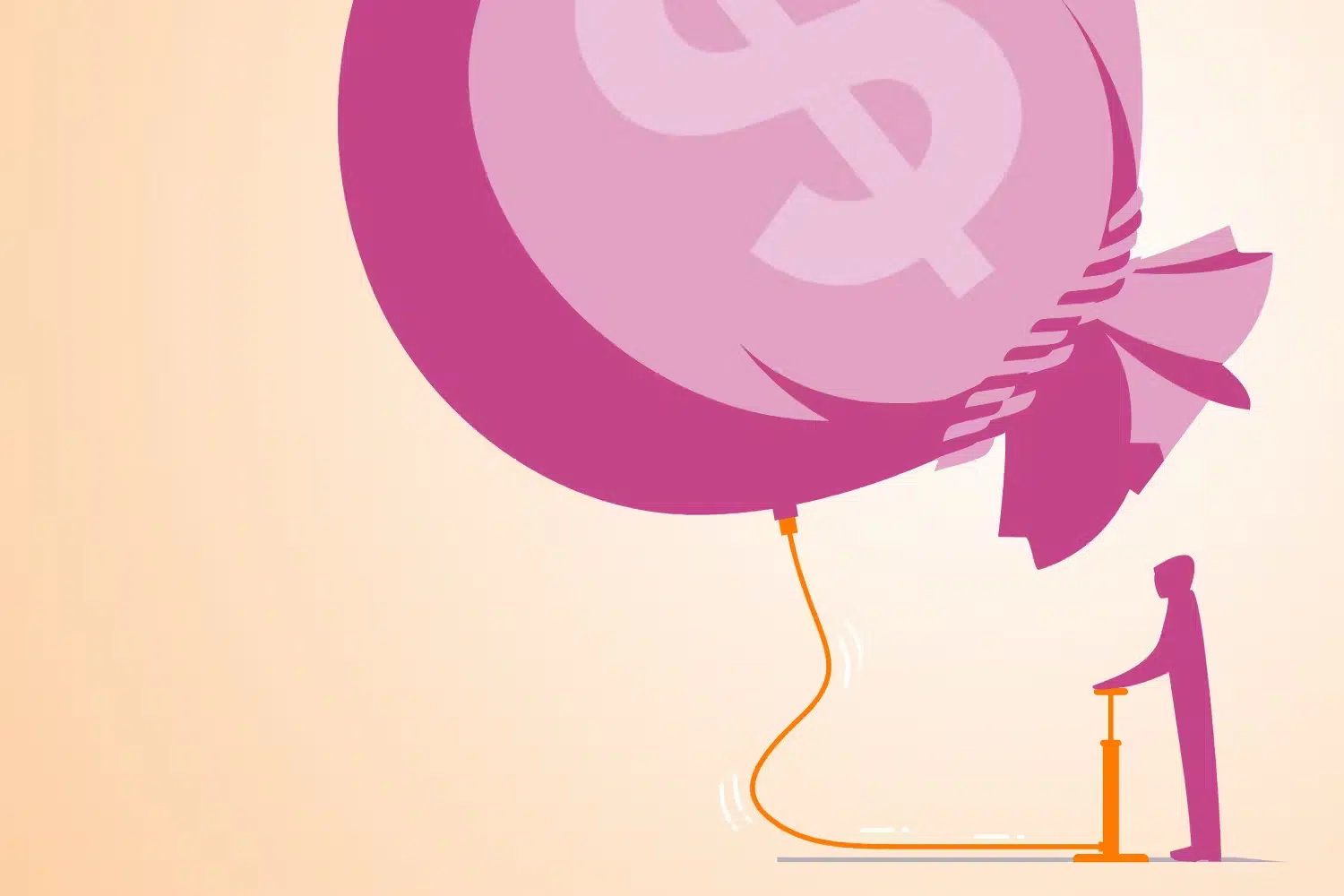
The Impact of Inflation on Bond Prices and Interest Rates

Though the ups and downs of the bond market are not usually as dramatic as the movements of the stock market, they can still have a significant impact on your overall return. If you’re considering investing in bonds, either directly or through a mutual fund or exchange-traded fund, it’s important to understand how bonds behave and what can affect your investment in them.
Important Bond Definitions to Know
Before we dive into inflation and interest rates, it’s important to understand a few terms related to bonds.
Bond price: This is what investors are willing to pay for a bond. This number can fluctuate.
Bond coupon rate: This is the annual interest rate that a bond pays. This number is fixed.
Bond yield: This is its overall return on your investment at any given time. Just as a bond’s price can fluctuate, so can its yield. A bond’s yield percentage depends not only on a bond’s coupon rate but also on changes in its price.
There are two fundamental ways that you can profit from owning bonds: from the interest that bonds pay or from any increase in the bond’s price. Many people who invest in bonds because they want a steady stream of income are surprised to learn that bond prices can fluctuate, just as any security traded in the secondary market.
For instance, if you sell a bond before its maturity date, you may get more than its face value— but you could also receive less if you must sell when bond prices are down. The closer the bond is to its maturity date, the closer to its face value the price is likely to be.
Looking for a Financial Advisor?
Schedule an Amplify Wealth Management appointment with our colleagues at CUSO Financial Services (CFS)*.
The Relationship Between Bond Yield and Price
Both bond prices and yields go up and down, but there’s an important rule to remember about the relationship between the two: They move in opposite directions, much like a seesaw.
When a bond’s price goes up, its yield goes down, even though the coupon rate hasn’t changed. The opposite is true as well: When a bond’s price drops, its yield goes up.
That’s true not only for individual bonds but also for the bond market as a whole. When bond prices rise, yields in general fall, and vice versa.
What impacts a bond’s price?
In some cases, a bond’s price is affected by something that is unique to its issuer — for example, a change in the bond’s rating. However, other factors have an impact on all bonds. The twin factors that affect a bond’s price are inflation and changing interest rates.
A rise in either interest rates or the inflation rate will tend to cause bond prices to drop. Inflation and interest rates behave similarly to bond yields, moving in the opposite direction from bond prices.
Let’s take a closer look at how inflation, interest rates, and bond prices all affect one another.
Inflation and Bond Prices
If inflation means higher prices overall, why do bond prices drop?
The answer has to do with the relative value of the interest that a specific bond pays. Rising prices over time reduce the purchasing power of each interest payment a bond makes. Let’s say a five-year bond pays $400 every six months. Inflation means that $400 will buy less five years from now.
When investors worry that a bond’s yield won’t keep up with the rising costs of inflation, the price of the bond drops because there is less investor demand for it.
Inflation and Interest Rates
Inflation also affects interest rates. If you’ve heard a news commentator talk about the Federal Reserve Board raising or lowering interest rates, you may not have paid much attention unless you were about to buy a house or take out a loan. However, the Fed’s decisions on interest rates can also have an impact on other investments.
The Fed takes an active role in trying to prevent inflation from spiraling out of control. When the Fed gets concerned that the rate of inflation is rising, it may decide to raise interest rates to try to slow the economy by making it more expensive to borrow money. For example, when interest rates on mortgages go up, fewer people can afford to buy homes. That tends to dampen the housing market, which in turn can affect the economy.
Interest Rates and Bond Prices
When the Fed raises its target interest rate, other interest rates and bond yields typically rise as well. That’s because bond issuers must pay a competitive interest rate to get people to buy their bonds. New bonds paying higher interest rates mean existing bonds with lower rates are less valuable. Prices of existing bonds fall.
That’s why bond prices can drop even though the economy may be growing. An overheated economy can lead to inflation, and investors begin to worry that the Fed may have to raise interest rates, which would hurt bond prices even though yields are higher.
Just the opposite happens when interest rates are falling. When rates are dropping, bonds issued today will typically pay a lower interest rate than similar bonds issued when rates were higher. Those older bonds with higher yields become more valuable to investors, who are willing to pay a higher price to get that greater income stream. As a result, prices for existing bonds with higher interest rates tend to rise.
Bond Investment Tips
Here are a few general things to keep in mind when investing in bonds.
1. Know your bond investment types.
Inflation and interest rate changes don’t affect all bonds equally. Under normal conditions, short-term bonds may feel the effects of any Fed action almost immediately, but longer-term bonds likely will see the greatest price changes.
2. Understand that bond mutual funds may behave differently.
Bond mutual funds may be affected somewhat differently than an individual bond. For example, a bond fund’s manager may be able to alter the fund’s holdings to try to minimize the impact of rate changes. Your financial professional may do something similar if you hold individual bonds.
Keep in mind that bond funds are subject to the same inflation, interest rate, and credit risks as their underlying bonds, and if interest rates rise and bond prices fall, that can adversely affect a bond fund’s performance. Before purchasing a mutual fund, you should carefully consider its investment objective, risks, fees, and expenses, which can be found in the prospectus available from the fund. Read it carefully before investing.
3. Focus on your overall goals.
Though it’s useful to understand generally how bond prices are influenced by interest rates and inflation, it probably doesn’t make sense to obsess over what the Fed’s next decision will be.
Interest rate cycles tend to occur over months and even years. Also, the relationship between interest rates, inflation, and bond prices is complex, and can be affected by factors other than the ones outlined here. Remember, investments seeking to achieve higher yields also involve a higher degree of risk.
Your bond investments need to be tailored to your individual financial goals and take into account your other investments. A financial professional may be able to help you design your portfolio to accommodate changing economic circumstances.
Inflation, Bond Prices, and Interest Rates at a Glance
A little lost? Don’t worry— it’s a lot of information to take in! Here’s a quick little recap of the basics.
- When prices rise due to inflation, bondholders worry that the interest they’re paid won’t buy as much later on.
- To control inflation, the Fed may raise interest rates to get investors to purchase bonds.
- When interest rates go up, borrowing costs rise. Economic growth and spending tend to slow.
- With less demand for goods and services, inflation levels off or falls. Bond investors worry less about the buying power of future interest payments. They may accept lower interest rates on bonds, and prices of older bonds with higher interest rates tend to rise.
- Interest rates in general fall, fueling economic growth and potentially new inflation.
Want to explore investing in bonds? Get in touch with a CFS* financial advisor today who can help build an investment profile for you.
*Non-deposit investment products and services are offered through CUSO Financial Services, L.P. (“CFS”), a registered broker-dealer Member FINRA/SIPC and SEC Registered Investment Advisor. Products offered through CFS: are not NCUA/NCUSIF or otherwise federally insured, are not guarantees or obligations of the credit union, and may involve investment risk including possible loss of principal. Investment Representatives are registered through CFS. The Credit Union has contracted with CFS to make non-deposit investment products and services available to credit union members.
Prepared by Broadridge Investor Communication Solutions, Inc. Copyright 2018.
Talk to a CFS* Financial Advisor
Want to take your retirement plans to the next level? Schedule an Amplify Wealth Management appointment with our colleagues at CUSO Financial Services (CFS)*.


